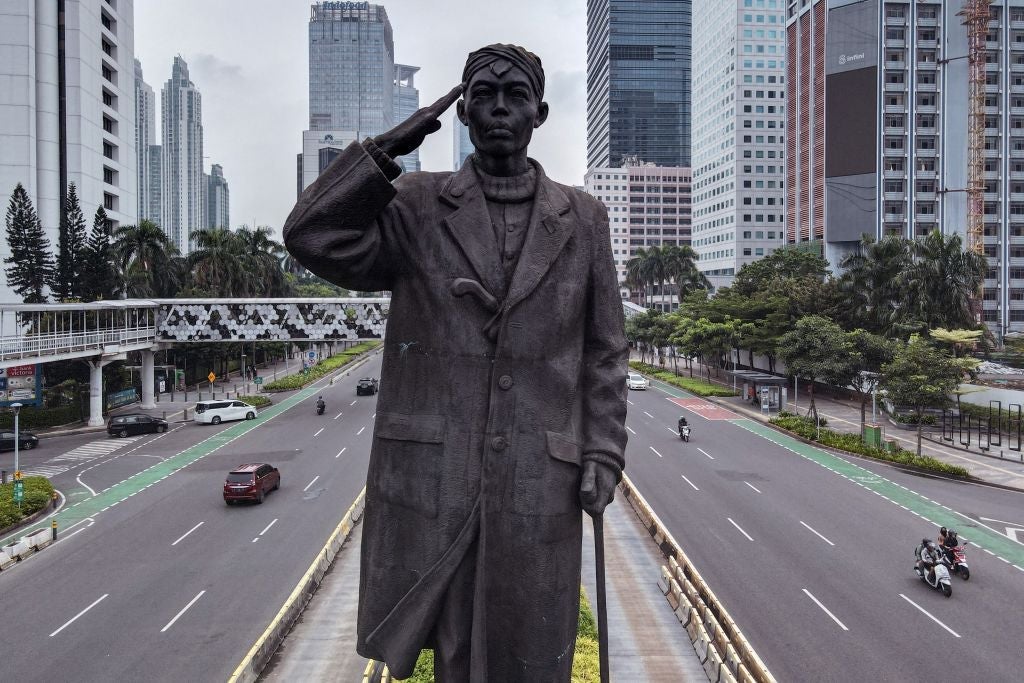
The Association of South East Asian Nations (Asean) has been in place for more than 50 years to promote economic and political cooperation between its member states – Brunei, Cambodia, Indonesia, Laos, Malaysia, Myanmar, Philippines, Singapore, Thailand and Vietnam.
According to the Asean Development Outlook report, the combined GDP of the ten countries reached $3.2trn in 2019, making the bloc the world’s fifth-largest economy. Through its coordinated Covid-19 recovery plans and other key developments, it is predicted to become the fourth largest by 2030.
Indonesia accounts for more than one-third of Asean GDP
Indonesia is the largest economy involved in Asean. At $1.1trn, it accounted for more than one-third of the combined GDP of the Asean member nations in 2020. Globally, Indonesia is the fourth most populous country and 16th largest economy by nominal GDP.
Following a period of decline during the Asian financial crisis of the late 1990s, Indonesia’s economy flourished throughout the 2000s and early 2010s. Its GDP grew at a compound annual growth rate (CAGR) of 17.2% between 2001 and 2012 before slowing down between 2013 and 2015 due to weaker commodity prices, a drop in consumer spending and reduced trade with China.
The economy bounced back in 2016, growing year on year until 2020 when it dipped by 5.7% in the fallout from the Covid-19 pandemic. According to the World Bank, the impact of the pandemic caused Indonesia to go from upper-middle income status to lower-middle income as of July 2021.

US Tariffs are shifting - will you react or anticipate?
Don’t let policy changes catch you off guard. Stay proactive with real-time data and expert analysis.
By GlobalDataIndonesia is currently in the process of fulfilling the National Long‐Term Development Plan, a 20-year strategy implemented from 2005 to 2025. The country has now reached the final stage of the plan, which is focused on improving talent and global competitiveness.
Thailand is the second-largest Asean economy, representing 16.7% of the bloc's overall GDP. The country's GDP grew at a CAGR of 5.3% between 2010 and 2019 before contracting by 8.9% in 2020. Its economic recovery post-Covid is expected to be sluggish given the country’s reliance on the tourism sector. Its GDP is reported to have increased by 1.6% in 2021.
The Philippines is the third-largest Asean nation by GDP, which measured $361.8bn in 2020. Its economy has grown rapidly since the early 2000s due to an expanding labour market, a growing middle class and strong remittances. Key business sectors in the country include semiconductors and other electronics, business process outsourcing, financial services and tourism.
Filipino GDP increased at a CAGR of 6.8% between 2010 and 2019 before dropping by 4.2% in 2020 in the wake of the pandemic. Despite this, the economy has recovered quickly and grew by 5.6% in 2021.
Singapore had the highest GDP per capita of all the countries analysed at $60,729 in 2020. It also recorded the lowest population growth at -0.31%. The city-state’s comprehensive fiscal policies, regulatory efficiency and political stability make it one of the world’s most business-friendly economies. As a result, Singapore ranked first in the Heritage Foundation’s 2022 Index of Economic Freedom.
Despite being the smallest economy within the Asean bloc, Brunei recorded the second-highest GDP per capita ($27,443) in 2020. Oil and gas is the country’s top economic sector by far, accounting for 90% of government revenue, 90% of exports and more than half of its GDP. Brunei also depends heavily on imports for the majority of its manufactured goods and food.
Laos experienced the highest population growth of all countries analysed at 1.5%. The country also had the highest inflation rate at 5.1%, which can largely be attributed to the rising cost of fuel as well as the depreciation of the Lao currency, the kip. As a result, the government decided to cut VAT from 10% to 7% in 2022 to improve productivity.
Myanmar, Vietnam and Laos were the only countries in the Asean region that grew their economies in 2020 despite the financial impact of Covid-19. Their GDPs increased by 13%, 3.7% and 1.3%, respectively, from 2019.
Singapore is the leading Asean destination for FDI
Foreign direct investment (FDI) inflows across the Asean countries fell significantly amid the fallout from the Covid-19 pandemic. Overall, FDI project numbers fell by 43% between 2019 and 2020.
Singapore is the top FDI destination among the Asean nations both in absolute and per capita terms. The city-state attracted 303 FDI projects in 2020, representing 5.3 projects per 100,000 people.
Key industries for investment in Singapore include ICT, aerospace, electronics, pharmaceuticals and professional services. Singapore is also a hub for advanced manufacturing activities and is the world’s fourth-largest exporter of high-tech products. Recent notable projects include US semiconductor manufacturer GlobalFoundries’ new fabrication plant and South Korean automotive giant Hyundai’s new global innovation centre, which is scheduled for completion by the end of 2022.
Vietnam is the second most popular investment destination in the Asean region, with 132 FDI projects in 2020, down 52% from 2019. The country’s leading sectors include tourism, electronics and financial services.
Oil and gas is also a top priority sector in the country. In late 2020, ExxonMobil received approval to develop a $5.09bn liquefied natural gas (LNG) plant in the port city of Hai Phong. US-based Millennium is also proposing to develop a $15bn LNG project in Khanh Hoa province.
Malaysia recorded the third-highest number of projects in the Asean region in 2020 with 100, a 42% drop from 2019. Key industries include tourism, green technologies and logistics. In January 2022, Malaysia was selected as the best country in emerging South East Asia for FDI attractiveness in the Milken Institute’s Global Opportunity Index due to its efforts to facilitate trade and attract foreign investment.
Laos and Brunei tie for least popular FDI destinations among the Asean countries, logging two FDI projects each in 2020.
Indonesia attracted the highest level of FDI-related capital investment in 2020. Despite the economic impact of Covid-19, FDI project values in the country jumped from $12bn in 2019 to $20.2bn in 2020.
Despite only receiving two FDI projects in 2020, Brunei recorded the second-largest amount of project investment. This can be attributed to a $13.7bn project that was announced in September of that year when China-based chemical fibre products manufacturer Hengyi unveiled plans to expand its refinery and petrochemical complex in Palau Muara Besar. In comparison, the country attracted FDI projects worth a combined total of $43.2m in 2019.
Singapore's business friendliness helps it shine
Singapore excelled across multiple indicators focused on business friendliness. It is the least corrupt of the Asean nations, scoring 85 out of 100 on Transparency International’s 2021 edition of the Corruption Perceptions Index. The country ranked fourth overall alongside Norway and Sweden.
It takes just one-and-a-half days on average to start a business in Singapore and the city-state has the largest number of broadband subscriptions of the countries analysed at 25.9 per 100 people in 2019.
In addition, Singapore has the lowest corporation tax rate of the Asean members at 17% and boasts a network of tax treaties with more than 85 countries. It also offers investors strong government support and intellectual property protection.
At 95%, Brunei had the highest share of its population using the internet, a significant increase from 53% in 2010. Myanmar had the lowest at 24%.
On average, more than 95% of the populations within Asean member states have electricity access, with Brunei, Laos, Malaysia and Singapore at 100%. Myanmar (68%) and Cambodia (93%) are the only two countries below the Asean average.
Cambodia is the most corrupt Asean country, with fraudulent activity particularly prevalent within the judiciary, customs services and tax authorities. It scored 23 out of 100 on the 2021 Corruption Perception Index. In 2010, the country adopted an Anti-Corruption Law and established an Anti-Corruption Unit, but enforcement remains weak.
It also takes 99 days on average to start a business in Cambodia, one of the longest wait times of the Asean countries and second only to Laos (173).
Which Asean countries lead for liveability?
In 2019, the gross enrolment ratio in tertiary education for Singapore was 91%. This is by far the highest rate among the Asean countries, with tertiary enrolment for the rest of the members at less than 50%. Laos recorded the lowest rate among the member states at 15% in 2019.
Singapore boasts a competitive and accomplished workforce where five out of ten workers are in high-skilled employment. Its bilingual education policy also encourages proficiency in both English and at least one other language including Mandarin, Malay and Tamil. In addition, the city-state had the lowest age dependency ratio – the ratio of dependants to working age population – of all countries analysed at 35%, and the highest life expectancy at 83.5 years on average.
Singapore’s unemployment rate hit an 11-year high of 5.2% in 2020 due to the economic downturn caused by Covid-19. It was also the country to experience the biggest increase in unemployment between 2019 and 2020, jumping by 2.1 percentage points. According to Singapore’s Minister of Manpower, Tan See Leng, unemployment has since fallen close to pre-pandemic levels.
Cambodia achieved the biggest improvement in life expectancy of all countries analysed, going from 53.6 years on average in 1990 to 69.8 in 2019. The country also had the lowest unemployment rate among the Asean nations at 0.3% in 2020. This is largely due to the dominance of Cambodia’s informal sector, where wages are often low and unregulated.
Myanmar has the lowest life expectancy among the Asean countries. Its average life expectancy in 2019 was 67.1 years. The dual impact of Covid-19 and a military coup in early 2021 have plunged the country further into economic and humanitarian crisis. The World Bank estimates that Myanmar’s poverty rate has doubled compared with pre-pandemic levels and one million jobs have been lost. Those still in employment have also reportedly experienced a decline in hours and/or wages.
Laos in front for renewable energy in Asean region
Indonesia was responsible for 36.5% of the carbon emissions made by Asean countries in 2018. In the same year, it ranked ninth globally, ahead of Canada, Saudi Arabia and Mexico. As part of a long-term strategy submitted to the UN, the country aims to reach net-zero greenhouse gas emissions by 2060 or sooner, with a planned peak by 2030.
The Philippines recorded the highest indexed increase in average temperature in the past 30 years, going from 25.7°C in 1991 to 26.3 °C in 2020. In a report published by the Institute for Economics and Peace, it is the country most at risk from the climate crisis due to rising sea levels, marine pollution and the increasing intensity of typhoons.
Renewable energy sources accounted for almost 97% of Laos’s energy mix in 2019. The country’s largest source of energy is hydropower, followed by bioenergy. Laos implemented its Renewable Energy Development Strategy in 2011 focused on developing its solar and wind energy capabilities.
More than 99% of Brunei’s energy mix comes from fossil fuels. The government has started to introduce measures to reduce the country’s over-dependence on oil and gas. It aims to increase the use of renewables to make up 30% of Brunei's power generation by 2035.







